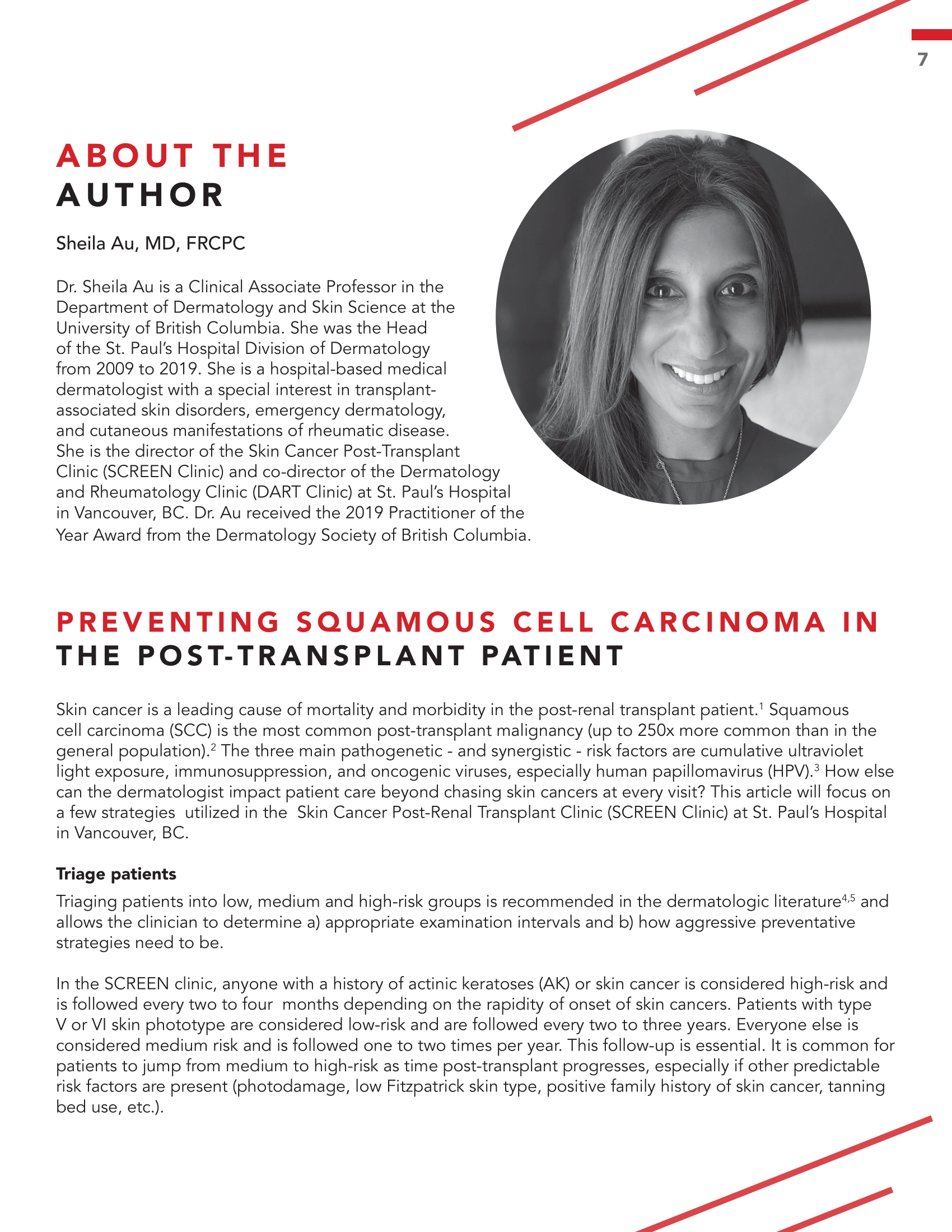Preventing squamous cell carcinoma in the post-transplant patient
Abstract
Skin cancer is a leading cause of mortality and morbidity in the post-renal transplant patient. Squamous cell carcinoma (SCC) is the most common post-transplant malignancy (up to 250x more common than in the general population). The three main pathogenetic – and synergistic – risk factors are cumulative ultraviolet light exposure, immunosuppression, and oncogenic viruses, especially human papillomavirus (HPV). How else can the dermatologist impact patient care beyond chasing skin cancers at every visit? This article will focus on a few strategies utilized in the Skin Cancer Post-Renal Transplant Clinic (SCREEN Clinic) at St. Paul’s Hospital in Vancouver, BC.
References
Howard MD, Su JC, Chong AH. Skin Cancer Following Solid Organ Transplantation: A Review of Risk Factors and Models of Care. Am J Clin Dermatol. 2018;19(4):585-97.
Moloney FJ, Comber H, O’Lorcain P, O’Kelly P, Conlon PJ, Murphy GM. A population-based study of skin cancer incidence and prevalence in renal transplant recipients. Br J Dermatol. 2006;154(3):498-504.
Perez HC, Benavides X, Perez JS, Pabon MA, Tschen J, Maradei-Anaya SJ, et al. Basic aspects of the pathogenesis and prevention of non-melanoma skin cancer in solid organ transplant recipients: a review. Int J Dermatol. 2017;56(4):370-8.
Mittal A, Colegio OR. Skin Cancers in Organ Transplant Recipients. Am J Transplant. 2017;17(10):2509-30.
Acuna SA, Huang JW, Scott AL, Micic S, Daly C, Brezden-Masley C, et al. Cancer Screening Recommendations for Solid Organ Transplant Recipients: A Systematic Review of Clinical Practice Guidelines. Am J Transplant. 2017;17(1):103-14.
O’Reilly Zwald F, Brown M. Skin cancer in solid organ transplant recipients: advances in therapy and management: part I. Epidemiology of skin cancer in solid organ transplant recipients. J Am Acad Dermatol. 2011;65(2):253-61.
Santos-Juanes J, Esteve A, Mas-Vidal A, Coto-Segura P, Salgueiro E, Gomez E, et al. Acute renal failure caused by imiquimod 5% cream in a renal transplant patient: review of the literature on side effects of imiquimod. Dermatology. 2011;222(2):109-12.
Ulrich C, Bichel J, Euvrard S, Guidi B, Proby CM, van de Kerkhof PC, et al. Topical immunomodulation under systemic immunosuppression: results of a multicentre, randomized, placebo-controlled safety and efficacy study of imiquimod 5% cream for the treatment of actinic keratoses in kidney, heart, and liver transplant patients. Br J Dermatol. 2007;157(Suppl 2):25-31.
Ulrich C, Busch JO, Meyer T, Nindl I, Schmook T, Sterry W, et al. Successful treatment of multiple actinic keratoses in organ transplant patients with topical 5% imiquimod: a report of six cases. Br J Dermatol. 2006;155(2):451-4.
Ulrich C, Jurgensen JS, Degen A, Hackethal M, Ulrich M, Patel MJ, et al. Prevention of non-melanoma skin cancer in organ transplant patients by regular use of a sunscreen: a 24 months, prospective, case-control study. Br J Dermatol. 2009;161(Suppl 3):78-84.
Herold M, Good AJ, Nielson CB, Longo MI. Use of Topical and Systemic Retinoids in Solid Organ Transplant Recipients: Update and Review of the Current Literature. Dermatol Surg. 2019;45(12):1442-9.
O’Reilly Zwald F, Brown M. Skin cancer in solid organ transplant recipients: advances in therapy and management: part II. Management of skin cancer in solid organ transplant recipients. J Am Acad Dermatol. 2011;65(2):263-79.
Ritchie SA, Patel MJ, Miller SJ. Therapeutic options to decrease actinic keratosis and squamous cell carcinoma incidence and progression in solid organ transplant recipients: a practical approach. Dermatol Surg. 2012;38(10):1604-21.
Otley CC, Berg D, Ulrich C, Stasko T, Murphy GM, Salasche SJ, et al. Reduction of immunosuppression for transplant-associated skin cancer: expert consensus survey. Br J Dermatol. 2006;154(3):395-400.
Jiyad Z, Olsen CM, Burke MT, Isbel NM, Green AC. Azathioprine and Risk of Skin Cancer in Organ Transplant Recipients: Systematic Review and Meta-Analysis. Am J Transplant. 2016;16(12):3490-503.
Plasmeijer EI, Sachse MM, Gebhardt C, Geusau A, Bouwes Bavinck JN. Cutaneous squamous cell carcinoma (cSCC) and immunosurveillance–the impact of immunosuppression on frequency of cSCC. J Eur Acad Dermatol Venereol. 2019;33(Suppl 8):33-7.
Karia PS, Azzi JR, Heher EC, Hills VM, Schmults CD. Association of Sirolimus Use With Risk for Skin Cancer in a Mixed-Organ Cohort of Solid-Organ Transplant Recipients With a History of Cancer. JAMA Dermatol. 2016;152(5):533-40.
Chen AC, Martin AJ, Choy B, Fernández-Peñas P, Dalziell RA, McKenzie CA, et al. A Phase 3 Randomized Trial of Nicotinamide for Skin-Cancer Chemoprevention. N Engl J Med. 2015;373(17):1618-26.
Drago F, Ciccarese G, Cogorno L, Calvi C, Marsano LA, Parodi A. Prevention of non-melanoma skin cancers with nicotinamide in transplant recipients: a case-control study. Eur J Dermatol. 2017;27(4):382-5.
Rouette J, Yin H, Pottegård A, Nirantharakumar K, Azoulay L. Use of Hydrochlorothiazide and Risk of Melanoma and Nonmelanoma Skin Cancer. Drug Saf. 2020.
Gupta R, Rady PL, Doan HQ, Tyring SK. Development of a ß-HPV vaccine: Updates on an emerging frontier of skin cancer prevention. J Clin Virol. 2020;126:104348.
Nichols AJ, Allen AH, Shareef S, Badiavas EV, Kirsner RS, Ioannides T. Association of Human Papillomavirus Vaccine With the Development of Keratinocyte Carcinomas. JAMA Dermatol. 2017;153(6):571-4.
Nichols AJ, Kirsner RS, Ioannides T. Use of Combination Systemic-Intratumoral HPV Vaccine to Treat Cutaneous Basaloid Squamous Cell Carcinomas-Reply. JAMA Dermatol. 2019;155(1):124-5.


